
How to navigate volcanic landscapes safely
What's the story
Africa's volcanic peaks present climbers with an unparalleled, challenging experience. These untouched landscapes demand careful preparation and knowledge to navigate through safely. From knowing the terrain to gearing up for unpredictable weather, climbers must be well-equipped with the right skills and gear. Here's a look at some essential tips for those looking to conquer these majestic peaks, ensuring a safe, rewarding adventure.
Tip 1
Understanding the terrain
Africa's volcanic peaks differ tremendously when it comes to the terrain. While some areas are rocky, others could be filled with loose gravel or ash. It is imperative to research the particular peak you intend to scale and learn about its unique features. This will help you select suitable footwear and gear, minimizing the chances of accidents.
Tip 2
Preparing for weather changes
Weather on Africa's volcanic peaks can be unpredictable, and it is something climbers should be ready for. The temperature, wind, and precipitation can change quickly, so climbers should pack layers of clothing that can easily be adjusted as conditions change. Waterproof gear is also a must to protect against unexpected rain or snow, keeping climbers dry and comfortable throughout their journey.
Tip 3
Acclimatization strategies
High altitudes on Africa's volcanic peaks can pose a major challenge to climbers owing to the lack of oxygen. To steer clear of altitude sickness, proper acclimatization is imperative. Climbers must plan a gradual ascent, giving their bodies plenty of time to adapt to the varying conditions. Staying well-hydrated and consuming high-energy foods are also important tactics that help acclimatization, ensuring a safer, enjoyable climb.
Tip 4
Essential gear checklist
Having the right gear is critical when climbing Africa's volcanic peaks. A sturdy pair of boots with good grip is essential to navigate rocky terrain safely. Other important items include a reliable backpack, navigation tools like maps or GPS devices, first-aid kits, and enough food supplies.
Tip 5
Safety measures on volcanic peaks
Safety should always be our priority while climbing any mountain range, but especially on volcanic peaks. For instance, conditions may suddenly change without any warning signs beforehand. Increased seismic activity, for example, could indicate a potential eruption nearby, putting climbers at serious risk. If you are planning to climb a volcanic peak, be sure to consult experts familiar with these environments.